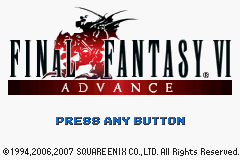Final Fantasy VI Advance
| Final Fantasy VI Advance |
|---|
|
Developers: TOSE[1],
Quintet[1]
|
Final Fantasy VI Advance is a port/remake of Final Fantasy VI to the Game Boy Advance, featuring two new optional dungeons (Dragon's Den and Soul Shrine) and a new optional superboss. Oh and the English script was completely retranslated from scratch, causing eternal confusion in strategy guides due to the totally different enemy names.
Also notable for being the last Game Boy Advance game in Japan.
Contents
Unused Text
All of the unused text from the SNES/PS Final Fantasy VI is still there, retranslated and everything.
| To do: Should be dumped. |
Regional Differences
Pincer Attack Bug
The European release fixed a bug that has been carried over all the way from the SNES version where Latimeria (SNES)/Oceanus (GBA) and L. 90 Magic (SNES)/Level 90 Magic (GBA) could pincer attack the party despite being alone.
Level Reset Bug
The US and European versions feature a bug that resets the characters' levels, allowing for easy stat maximization.
- On a save file that features the characters whose levels should be reset, save the game, then quicksave.
- Return to the title screen and start a new file. (This erases the quicksave.)
- Without ever saving, play the game up to the point where the desired characters join the party.
- Get a Game Over.
The game will throw you back to the last savefile, but the levels of all characters that joined up to that point will be reset to what it was at the moment the Game Over occurred.
This bug doesn't occur in the Japanese version, which simply sends you back to the title screen.
References
- Games developed by TOSE
- Games developed by Quintet
- Pages missing publisher references
- Games published by Square Enix
- Games published by Nintendo
- Game Boy Advance games
- Pages missing date references
- Games released in 2006
- Games released in November
- Games released on November 30
- Games with unused text
- Games with regional differences
- To do
- Final Fantasy series
Cleanup > Pages missing date references
Cleanup > Pages missing publisher references
Cleanup > To do
Games > Games by content > Games with regional differences
Games > Games by content > Games with unused text
Games > Games by developer > Games developed by Quintet
Games > Games by developer > Games developed by TOSE
Games > Games by platform > Game Boy Advance games
Games > Games by publisher > Games published by Nintendo
Games > Games by publisher > Games published by Square Enix
Games > Games by release date > Games released in 2006
Games > Games by release date > Games released in November
Games > Games by release date > Games released in November > Games released on November 30
Games > Games by series > Final Fantasy series
